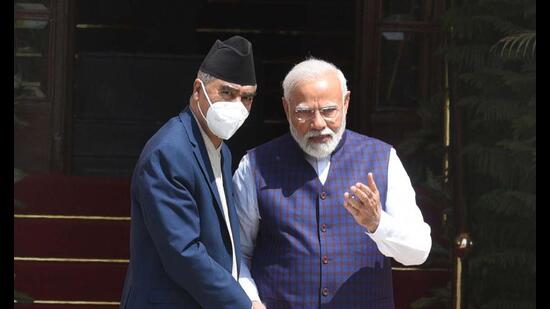Nepal is making efforts to reset ties with India
Nepal’s fluid internal politics and the larger geopolitical situation offer New Delhi a window to reflect on its foreign policy priorities
During his visit to New Delhi last month, former Nepal prime minister (PM) Pushpa Kamal Dahal (Prachanda)’s political life seems to have come full circle. Once a Maoist firebrand, who never failed to lash out at “expansionist” India, Prachanda showed his pragmatic side during the visit. “As a home of natural heritage and religious sites,” Prachanda told the audience at a think tank, “Nepal warmly welcomes Indian tourists… Be it for nature, culture or, for adventure, we expect an increased flow of Indian visitors in the days ahead. [The] Ramayana Circuit, Buddhist Circuit, Shiva Circuit and other religious sites, including Pashupatinath, Muktinath, Janakpurdham, solemnly represent our civilisational bonds and potential for scaling up religious tourism.”

Prachanda sounded more like PM Narendra Modi than a Maoist who waged a 10-year underground “people’s war” until 2006. This change has been in the making for some time now. The Communist Party of Nepal (Maoist) became the leading party in the 2008 elections. As PM, Prachanda’s first foreign visit was to Beijing to attend the Olympics. The revolutionary must have harboured dreams of a China-like socio-economic transformation of Nepal and cementing his legacy in the world. Fourteen years on, however, Prachanda has a realistic view of the world, accepting his limitations and the complexities of the political landscape of Nepal, where a democratic India and communist China have competing interests.
Prachanda, invited by the Bharatiya Janata Party (BJP) president, JP Nadda, expressed his intent to develop party-to-party ties with India’s largest party. Though he could not meet PM Modi, Prachanda is aware of the latter’s political appeal in Nepal. During his two trips — Janakpur in 2018 and Buddha’s birthplace Lumbini in May — Modi charmed the Nepalis, addressing them in Maithili, Hindi, and Nepali.
Prachanda’s Delhi visit came two days after Liu Jianchao, the head of the Chinese Communist Party’s international liaison department, left Kathmandu. Liu held talks with all senior Communist leaders, including Prachanda. Liu’s predecessor had held more meetings with Prachanda than any other South Asian leader. China wants Nepal’s Communist parties to come together before the general election (possibly in mid-November), or at least form an electoral alliance, as the Maoists and Communist Party of Nepal-Unified Marxist Leninist (CPN-UML) did in 2017, and later came together as the Nepal Communist Party (NCP).
As Nepal prepares for elections, the once-mighty NCP has split into three parties. Prachanda stands on shaky political ground, though his party fared well in the May 7 local elections. Buoyed by this success, he seems keen to continue the new electoral alliance with the centrist Nepali Congress, PM Deuba’s party, which has replaced the CPN-UML, the main Opposition in Parliament, as the largest party at the local level. The Maoists ended up as a creditable third political force. Prachanda wants the BJP leadership to treat his party independent of the BJP’s ties with the Nepali Congress and, as important, he wants the BJP to recognise that his party has left behind its radical past.
Prachanda visited India when Kathmandu was worried about the ballooning import bill and depleting foreign currency reserves. Inflation is at a six-year high, and Sri Lanka is a favourite talking point. Therefore, Kathmandu is anxious to deepen its economic partnership with India in many areas such as trade, hydropower, and connectivity.
When Deuba visited Delhi in April, the two sides issued a vision statement on power sector cooperation. Nepal exports over 360 MW to India during the wet season. But there’s potential for more, including roping in Bangladesh under the Bangladesh, Bhutan, India, Nepal (BBIN) framework. Prachanda also pointed out that Modi’s Neighbourhood First policy can provide momentum to South Asia’s regional and sub-regional trade, transit, connectivity, and hydropower processes.
Nepal’s fluid internal politics and the larger geopolitical situation offer New Delhi a window to reflect on its foreign policy priorities. PM Modi has made the common cultural heritage and values a bedrock of his diplomacy. The Nepalis are now keen to see tangible economic dividends to cement our civilisational bonds. Should that happen, the tired narrative of India-baiting will find less traction in Kathmandu.
Akhilesh Upadhyay is senior fellow, IIDS
The views expressed are personal
All Access.
One Subscription.
Get 360° coverage—from daily headlines
to 100 year archives.



HT App & Website






